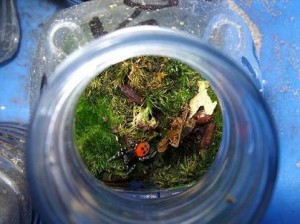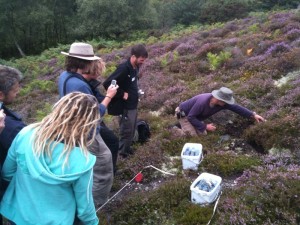Today I’ll be at the Bird Fair (come up and say hello – and perhaps buy a copy of Blogging for Nature from me) but last Thursday I was still on holiday in Dorset having not seen white-beaked dolphin and not seen Adonis blue butterfly. What would I not see next?
Arne had already provided nightjar, lots of grayling butterflies, a distant calling Dartford warbler, cracking views of raft spiders and my first ever wasp spider but today it was going to go one better, I hoped.
I had seen the press release and heard Toby Branston on the Today programme having to cope with Jim Naughtie’s helpful interjections as he explained that Arne was expecting a car-load of ladybird spiders to arrive any moment now.
The ladybird spiders, 29 of them, six adult males and six adult females, and a bunch of immatures, arrived in their own individual plastic drinks bottles. As well as the Today programme there was good coverage elsewhere ( eg BBC online, Daily Mail, Guardian) but none of them was there to see the spiders arrive or to talk to Ian Hughes who had been looking after them in deepest Wales over the winter.

You mustn’t judge invertebrates by our own standards – obviously – but it’s just as well. Male ladybird spiders (they are the ones who look a bit like ladybirds) mature at 2-3 years old, mate once and then die. That’s it! No getting the hang of it, developing your technique or getting over those first night nerves. Once, and you’re dead. It’s perhaps even worse for the females – it often is. They live a bit longer, mate once, look after the eggs in their egg sac and then hole themselves and the hatched spiders away. As the females die they are thought to feed their young hatchling spiders drops of fluid before probably being gobbled up anyway by their offspring who burst free into the world to start it all off again. I wonder whether they know it’s a couple of years of catching beetles and spiders and then when you get lucky, wham! bam! drop dead mam!
Ladybird spiders don’t even get around much – a colony will spread by about a metre a year if it’s really motoring. The 29 bottle-dwelling spiders had started life a few miles from Arne, gone to deepest Wales and come back to within about 8 miles of where they started. Eight miles would be like going to the moon for a ladybird spider but these have gone to Wales and back too! They can think about that for their brief lives on the sunny, south-facing, heather slope with attractive views over Poole Harbour where they were released.

They arrived in 29 plastic bottles and the cunning nature of those bottles now became clear. Peel off a couple of layers of tape and remove the top and bottom of the bottles and you just plant your spiders in their own little ecosystems in the Dorset soil. All 29 went into the same small area of a few square metres so there may be a Welsh choir of ladybird spiders somewhere at Arne from now onwards.
This is the type of project that I support whole-heartedly – it’s giving thratened nature a helping hand on a very important habitat, and it’s quite cheap. Fingers crossed for the ladybird spiders.
I couldn’t help but remember that I volunteered at Arne as a 17-year old back in August 1975. I spent two weeks living in a caravan-cum-hut in the woods and the then warden, Brian Pickess, handed me my A-level results at Arne – these things arrived by post in those far-off days.
I think those two weeks got me even more securely hooked on nature. Arne is a lovely place, the people were nice, even carrying a car battery around for Brian’s moth trap felt like a privilege at the time, and I saw lots of wildlife such as the smooth snakes that lived under the hut, the Dartford warblers with colour rings that were being studied by Colin Bibby who years later would recruit me to the RSPB, the non-native Sika deer which are now being culled to protect the wet heathland and the sand lizards which were new to me.
And I still love Arne to bits – go visit if you can.
And I’ll see you at the Bird Fair, maybe, some time over the weekend?
[registration_form]
Seems a shame that something so pretty should have such a disappointing sex life. Looking at myself in the mirror this morning, I knew exactly how the ladybird spider must feel (sigh…) 😉
But your blog got me thinking about other great animal impersonators. The buff-tip moth is my favourite. I wonder how many people see them and think they are looking at birch twigs? And then there’s the hummingbird hawk-moth, of course.
Hope this does not turn out to be the biggest misguided project ever as spiders located to Arne Reserve which is known to have the largest population of Dartford Warblers in the country and guess what they feed on to survive the winter.Well of course all these knowledgable conservationists know that although the answer is spiders the D W will leave these relocated ones to increase.Strange we were at Arne Reserve the day before release and have to say Paul and Rob have moved the reserve onto another level(may be cynical but always happy to praise exceptional work and enthusiasm and great credit for solving massive problem Arne had with dogs)Well done lads and Arne must have just about the most dedicated staff and volunteers in the conservation world.